|
Intaglio
In
the intaglio printmaking process, lines of an image to
be printed on paper are incised first by hand-held tools
and/or acids onto the surface of (generally) a flat
metal plate, most often, copper. The surface of
the metal plate is inked and then wiped so the only ink
that remains is in the incised areas of the plate.
The paper is carefully positioned on top of the
inked metal plate and "pulled" through a press, pressure
pushing the paper onto the inked plate allowing the ink
to be transferred to the paper producing an original
print, or graphic.
With intaglio prints one can observe the outer edge of
the metal plate impressed into the paper due to the
pressure of the printing press. The paper margins
extend beyond the plate mark. Some of Picasso's
prints were printed on smaller margined papers and some
of the same image were printed on larger paper and
therefore wider margins. Engraving, drypoint,
etching, and aquatint are intaglio forms of
printmaking. Picasso is known for having extended
the boundaries and traditional means of the printmaking
techniques shown below and often combined techniques in
producing his original graphics.
Engraving
An
engraving is made by first drawing a design directly
into a metal plate using a hand-held sharp cutting
device called a burin. The burin has a sharp,
angled point at the end. The engraving technique
had been used for centuries to reproduce drawings and
paintings, a way to allow more people to own or see the
works of art by artists who would otherwise only have
the original without the possibility of additional
"copies" of the unique image. By the 19th century,
it had been largely abandoned in favor of etching.
Although Picasso's use of the burin was not always
orthodox, he and other artists would use the burin to
create sharp crisp lines on the etching plate,
translated to the same on the printed image.
Drypoint
A
drypoint (form of engraving) is made by scratching
a sharp needle into a metal plate, raising tiny ridges
that also catch ink. When the plate is printed, the
ridges produce a velvet-like burr. After a few
printings, however, the fragile burr wears out. This
technique dates back to the 15th century, and although
it is not widely used, it includes Dürer and Rembrandt
among its practitioners. Picasso used drypoint
combined with original print-making techniques, usually
to produce lines of simplicity and expressive
quality.
Etching
In
etching, a metal plate is covered with an acid-resistant
ground, usually varnish, through which the image is
drawn with a pointed tool, exposing the metal below. The
plate is then immersed in a bath of acid that bites away
the metal where it was exposed by the drawn areas that
were no longer protected by the ground. After the plate
has been "etched" and cleaned, it is ready to be inked
and printed -- or reworked by the artist. The
relatively rapid execution allowed by this technique is
the primary reason for its widespread use shortly after
its development in the 15th century. Rembrandt, in
the 17th century, created more than 300 etchings.
Picasso, in 1968, created 347 etchings for a single
suite at age 87!
Aquatint
Aquatint
is similar to etching, but uses sprinkled grains of
heated resin instead of varnish for the ground. Aquatint
creates fields of tone, not line. The "sugar-lift"
method, which Picasso employed frequently in the 347 Series, allowed
the artist to paint or draw freely and swiftly with a
brush directly on the metal plate. Aquatint was invented
in the 18th century as a variation on etching.
Sugar aquatint or
lift-ground etching was mastered by Picasso in
1936. The etching technique preserves the
artist's brushwork and permits broad areas of color
instead of just thin, dry lines.
Picasso would draw directly on the metal plate with
a black watery ink thickened by the addition of
dissolved sugar and gum Arabic. The dried
drawing is then covered with an acid-resistant
varnish or etching ground and immersed in warm
water. This penetrates the ground and
dissolves the drawing material. The plate is
lightly rubbed so that the drawing as well as the
varnish on top of it "lift off", leaving the
bare plate. The protecting vanish will still
stick to the plate where the plate has not
previously been treated with the ink and sugar
mixture.
With copper plates the direct action of the acid is
not sufficient and is too smooth, leaving gray tones
were the acid has been bitten directly into the
plate. To achieve textures like brushstrokes Picasso
would lay down an aquatint ground on the lifted
design. This resin ground now covers the bare
metal of the open lines or brush stokes lifted from
the first ground and provides well defined textures
and tones. When preparing the artwork on the
plate the artist would work spontaneously with the
pen or brush. Sugar-lift etchings are often
combined with aquatint. Picasso liked the
medium (even though it was difficult to control)
because of the variety of textures it would produce.
With an aquatint a porous ground of
acid-resistant particles is used to cover areas of
the metal plate. Heat is then used to fuse the
particles to the plate. This allows the acid
to bite away a fine grid of small dots into the
plate as when the plate is dipped in an acid bath,
the particles prevent bits of the surface from being
eaten away. The resulting dot texture creates
an illusion of tonal range that Picasso
favored.
Scraper
Picasso
often employed a scraper, an engraver's tool that
removes bits of metal, in his intaglio prints. He
modified engraved and etched lines with its triangular
edge, which he also scraped into areas of aquatint.
Sometimes he used the scraper's sharp edge to engrave
strokes that are parallel and short, or as a substitute
for a drypoint needle.
Lithograph
Lithographs
are
made by creating a drawing on a flat prepared surface,
usually a large and heavy slab of thick Bavarian
limestone. The drawing, made with a greasy crayon
or similar material, is then stabilized with a
gum-arabic solution. The plate (or flat stone)
would then be sponged with water, the greasy drawn areas
repelling the water but attracting the rolled-on ink and
the rest of the stone remaining wet and repelling the
ink. Paper is positioned over the plate, and the
pressure of the press transfers the ink from the stone
to the paper, printing a reverse image of what was
drawn. The dates in reverse in so many of
Picasso's prints is due to this fact.
Picasso
also created lithographs on zinc plates as they were
lighter and did not require him to work at the
lithographer's studio. It was 1945 that Picasso
took up residence at the Mourlot studio in Paris
enjoying the medium where he could rework an image on
the same printing surface and preserve the complete
evolution of the composition.
Picasso
later created his lithographic images on a paper which
was then transferred to the stone in reverse from the
original drawing. Then, when printed, the print
would be a reverse of the inked surface, thereby
consistent with the orientation of the original
drawing. In examples where Picasso's date is read
correctly, it is likely that the print was made by
transferring a drawing to the plate.
Linocut
Picasso's linocuts were
made by gouging out a sheet of linoleum which had been
fused onto a harder block of wood. (Linoleum,
softer and lighter than wood, allowed Picasso to work
more quickly than would have been possible by working
from woodblocks alone.) Using gouges, he would
cut out the areas of his intended image that were to
be absent of color (and therefore appear the color of
the paper when printed). The relief areas that
remain would be inked, usually with a brayer.
Paper would be put on the inked linoleum block and
pressure applied, after which the inked image is
transferred to the paper. If there were to be
multiple colors, Picasso would create a separate
linoleum block, each corresponding to a different
color, each printed in succession. This is how
he worked since his first linocuts were created in
1958.
In later years he become more economical and
ingenious, inventing the technique of printing
multiple colors from a single linoleum block by
printing the linocut, cutting out more of the block,
inking it again and printing it a second time in a
second color on the earlier printed single-color
example, successively adding colors while continuing
the process.
Steel Facing
Picasso
would
often have his etching plates steel faced.
That process involves electroplating the
already-drawn etching plate with a very thin coat of
steel to harden its surface. In doing so,
early prints would have the same quality as later
prints. Before plates were steel faced, as in
Rembrandt's time in the 17th century, the etched
lines of earlier impressions were usually blacker,
richer, and more velvety and later impressions were
grayer, flatter, and not as rich due to the lines
being worn over the course of printing an
edition. Later impressions would display a
diminishing of subtle contrasts and tonal depth from
early to later impressions.
In
this Saper Galleries exhibition are several examples
of trial and other proofs created before the etching
plates were steel faced, thereby creating richer and
more desirable impressions than those from steel
faced plates which reduce textural delicacy and
tonal depth to a degree.
|
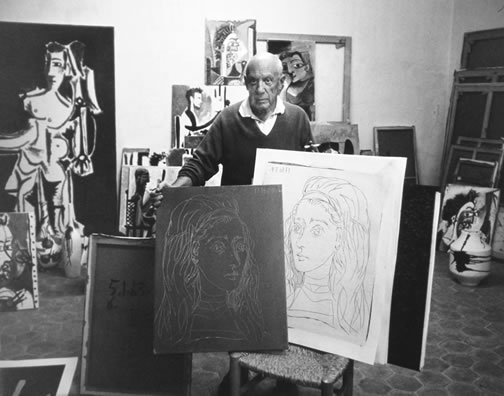 Picasso
with
linocut plate and print, 1957
Picasso
with
linocut plate and print, 1957
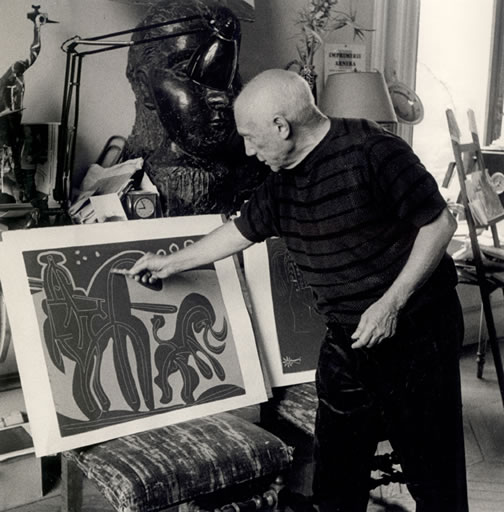
Picasso
with
linocut, 1959
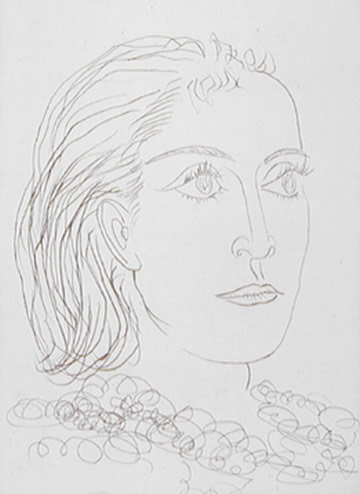
Drypoint
example,
1937
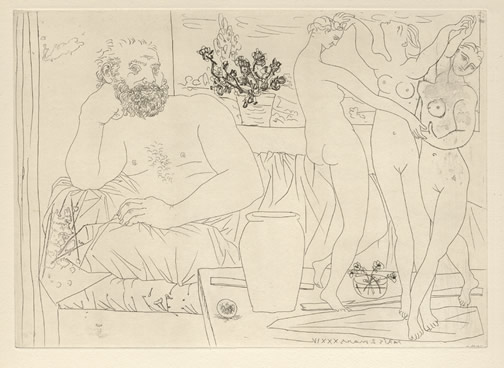
Etching
example,
1934
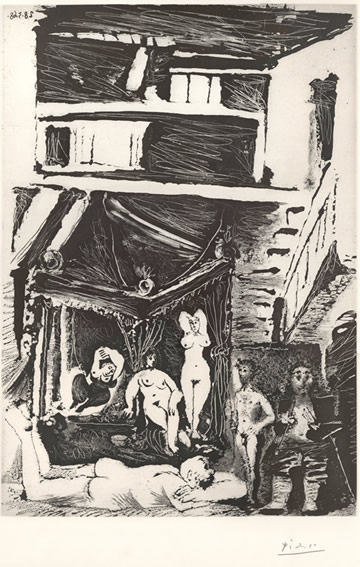
Sugar-lift
and
aquatint example, 1968
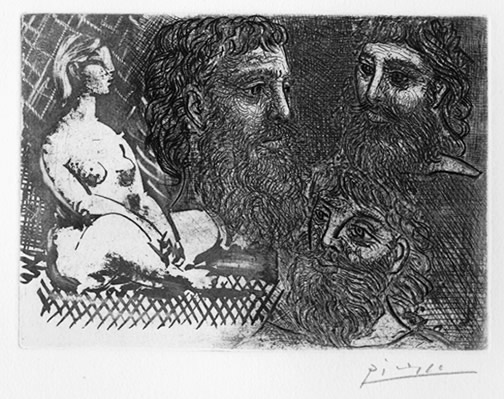
Sugar-lift aquatint example, 1934
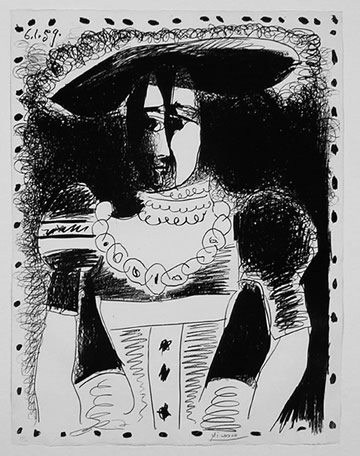
Lithograph, 1959
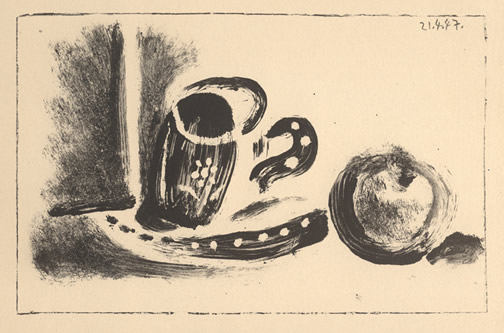
Lithograph transferred from drawing to stone, 1947
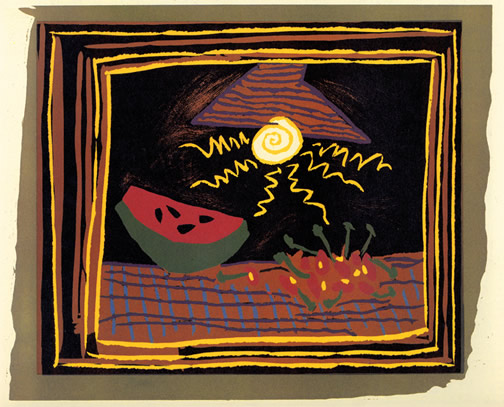
Seven-color linocut, 1962
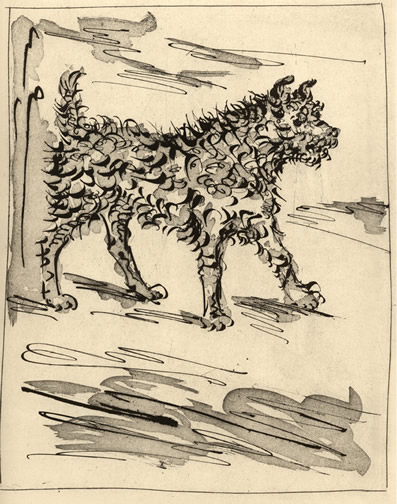
Etching
before
steel facing, 1941-42
|














